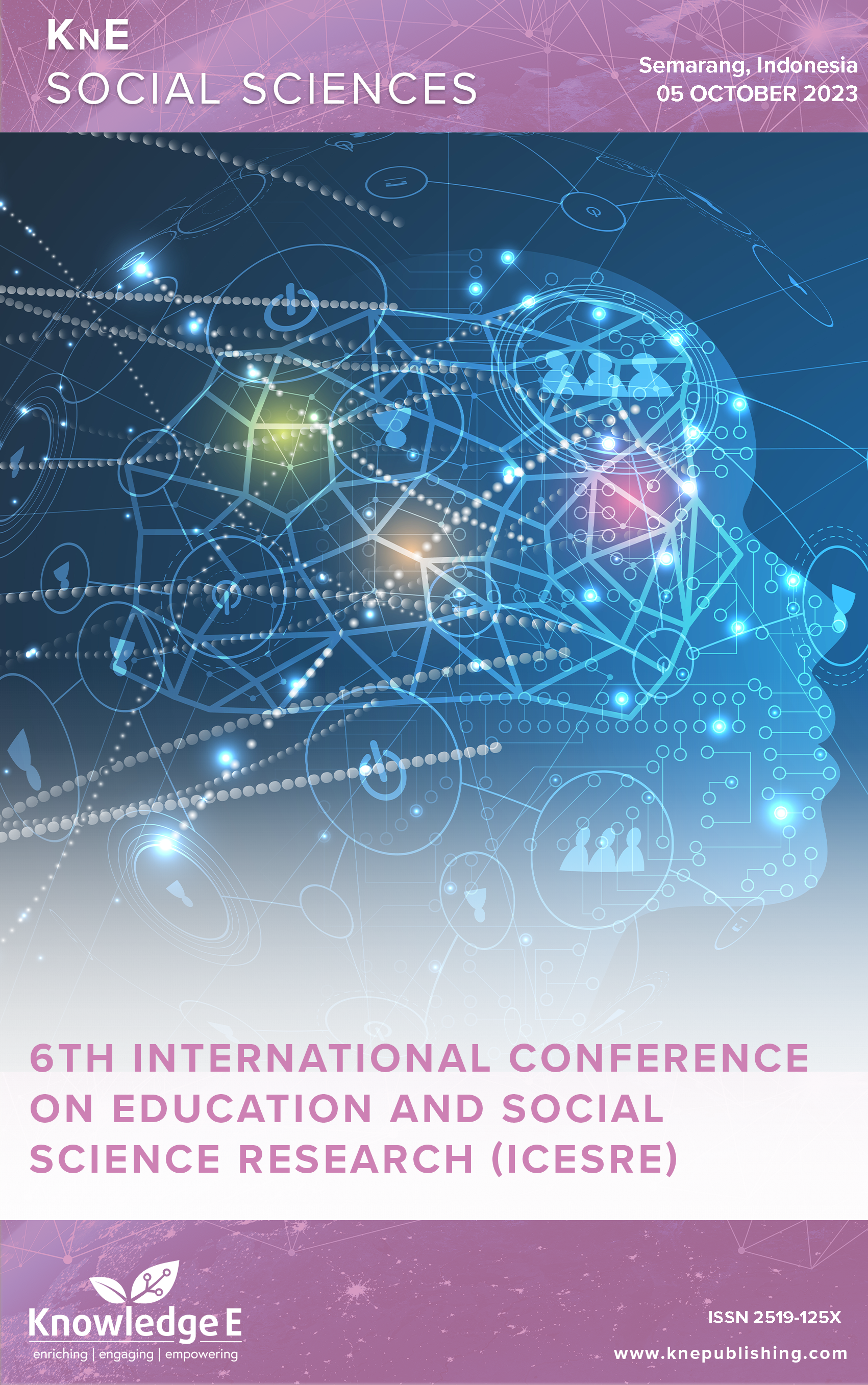Exploring the Design Thinking Orientation in English as a Foreign Language (EFL) for Learners: An Instrument Development Study
DOI:
https://doi.org/10.18502/kss.v9i6.15269Abstract
Design thinking has transformed many areas but is still under-researched in English as a Foreign Language (EFL) education. The research aims to develop an instrument for assessing design thinking in the EFL context. The study engaged 107 undergraduate students aged between 18 and 25 years from English-centric programs, ensuring a diverse sample with a balanced gender representation. Participants were briefed about the study’s objectives and voluntarily contributed during class hours. Confirmatory factor analysis (CFA) was utilized to assess the instrument’s factorial, convergent, and discriminant validity and Cronbach’s alpha-gauged internal consistency. Data analysis was executed using AMOS software, focusing on model fit, reliability, and validity. Findings reveal a structured guide to enhance students’ understanding of design thinking, emphasizing empathy’s central role in innovation. The study exhibits solid reliability and construct validity, with subtle deviations in model alignment. Limitations include sample size, geographical scope, and potential overlook of design thinking dimensions. Future research should explore cross-cultural validations and additional design thinking aspects to enrich understanding.
Keywords: design thinking, instrument development, evaluation
References
ElShishtawy N, Sinha P, Bennell JA. A comparative review of zero-waste fashion design thinking and operational research on cutting and packing optimisation. International Journal of Fashion Design, Technology and Education 2022;15:187– 99. https://doi.org/10.1080/17543266.2021.1990416. DOI: https://doi.org/10.1080/17543266.2021.1990416
Todoroff EC, Shealy T, Milovanovic J, Godwin A, Paige F. Comparing Design Thinking Traits between National Samples of Civil Engineering and Architecture Students. Journal of Civil Engineering Education 2021;147. https://doi.org/10.1061/(ASCE)EI.2643-9115.0000037. DOI: https://doi.org/10.1061/(ASCE)EI.2643-9115.0000037
Lichtenthaler U. Agile Innovation. International Journal of Service Science, Management, Engineering, and Technology 2020;11:157–67. https://doi.org/10.4018/IJSSMET.2020010110. DOI: https://doi.org/10.4018/IJSSMET.2020010110
Nakata C, Hwang J. Design thinking for innovation: Composition, consequence, and contingency. J Bus Res 2020;118:117–28. https://doi.org/10.1016/j.jbusres.2020.06.038. DOI: https://doi.org/10.1016/j.jbusres.2020.06.038
Tsai M-J, Wang C-Y. Assessing Young Students’ Design Thinking Disposition and Its Relationship With Computer Programming Self-Efficacy. Journal of Educational Computing Research 2021;59:410–28. https://doi.org/10.1177/0735633120967326. DOI: https://doi.org/10.1177/0735633120967326
Clarke RI, Amonkar S, Rosenblad A. Design thinking and methods in library practice and graduate library education. Journal of Librarianship and Information Science 2020;52:749–63. https://doi.org/10.1177/0961000619871989. DOI: https://doi.org/10.1177/0961000619871989
Sandars J, Goh P-S. Design Thinking in Medical Education: The Key Features and Practical Application. J Med Educ Curric Dev 2020;7:238212052092651. https://doi.org/10.1177/2382120520926518. DOI: https://doi.org/10.1177/2382120520926518
Noh SC, Karim AMA. Design thinking mindset to enhance education 4.0 competitiveness in Malaysia. International Journal of Evaluation and Research in Education (IJERE) 2021;10:494. https://doi.org/10.11591/ijere.v10i2.20988. DOI: https://doi.org/10.11591/ijere.v10i2.20988
Eden H, Mueller J. Teaching and learning design thinking (DT). Canadian Journal of Education 2020;43:498–521.
Balakrishnan B. Exploring the impact of design thinking tool among design undergraduates: a study on creative skills and motivation to think creatively. Int J Technol Des Educ 2022;32:1799–812. https://doi.org/10.1007/s10798-021-09652-y. DOI: https://doi.org/10.1007/s10798-021-09652-y
Hokanson B, Kenny R. Creativity and Critique as Formative Processes in Design Thinking. J Form Des Learn 2020;4:2–4. https://doi.org/10.1007/s41686-020-00047- 1. DOI: https://doi.org/10.1007/s41686-020-00047-1
Cummings C, Yur-Austin J. Design thinking and community impact: A case study of project-based learning in an MBA capstone course. Journal of Education for Business 2022;97:126–32. https://doi.org/10.1080/08832323.2021.1887795. DOI: https://doi.org/10.1080/08832323.2021.1887795
Randhawa K, Nikolova N, Ahuja S, Schweitzer J. Design thinking implementation for innovation: An organization’s journey to ambidexterity. Journal of Product Innovation Management 2021;38:668–700. https://doi.org/10.1111/jpim.12599. DOI: https://doi.org/10.1111/jpim.12599
Verganti R, Dell’Era C, Swan KS. Design thinking: Critical analysis and future evolution. Journal of Product Innovation Management 2021;38:603–22. https://doi.org/10.1111/jpim.12610. DOI: https://doi.org/10.1111/jpim.12610
Shafiee S, Haug A, Shafiee Kristensen S, Hvam L. Application of design thinking to product-configuration projects. Journal of Manufacturing Technology Management 2020;32:219–41. https://doi.org/10.1108/JMTM-04-2020-0137. DOI: https://doi.org/10.1108/JMTM-04-2020-0137
Wrigley C, Mosely G, Mosely M. Defining Military Design Thinking: An Extensive, Critical Literature Review. She Ji: The Journal of Design, Economics, and Innovation 2021;7:104–43. https://doi.org/10.1016/j.sheji.2020.12.002. DOI: https://doi.org/10.1016/j.sheji.2020.12.002
Lorusso L, Lee JH, Worden EA. Design Thinking for Healthcare: Transliterating the Creative Problem-Solving Method Into Architectural Practice. HERD: Health Environments Research & Design Journal 2021;14:16–29. https://doi.org/10.1177/1937586721994228. DOI: https://doi.org/10.1177/1937586721994228
Coleman E, Shealy T, Grohs J, Godwin A. Design thinking among first?year and senior engineering students: A cross?sectional, national study measuring perceived ability. Journal of Engineering Education 2020;109:72–87. https://doi.org/10.1002/jee.20298. DOI: https://doi.org/10.1002/jee.20298

